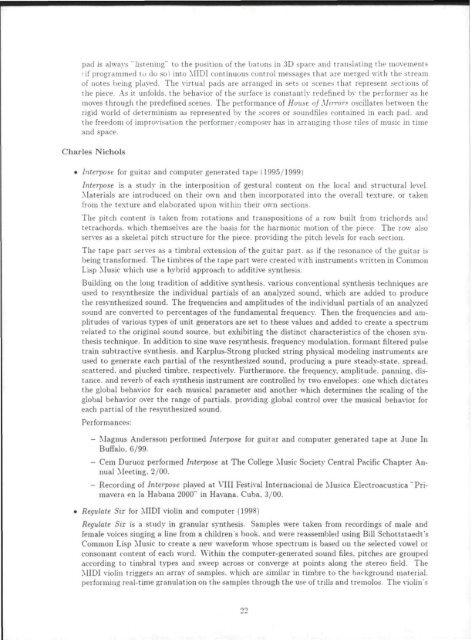Download - CCRMA - Stanford University
Download - CCRMA - Stanford University
Download - CCRMA - Stanford University
You also want an ePaper? Increase the reach of your titles
YUMPU automatically turns print PDFs into web optimized ePapers that Google loves.
pad is always "listening" to the position of the batons in 3D space and translating the movements<br />
1 if programmed to do so) into MIDI continuous control messages that are merged with the stream<br />
of notes being played. The virtual pads are arranged in sets or scenes that represent sections of<br />
the piece. As it unfolds, the behavior of the surface is constantly redefined by the performer as he<br />
moves through the predefined scenes. The performance of House of Mirrors oscillates between the<br />
rigid world of determinism as represented by the scores or soundfiles contained in each pad. and<br />
the freedom of improvisation the performer/composer has in arranging those tiles of music in time<br />
and space.<br />
Charles Nichols<br />
• Interpose for guitar and computer generated tape (1995/1999)<br />
Interpose is a study in the interposition of gestural content on the local and structural level.<br />
Materials are introduced on their own and then incorporated into the overall texture, or taken<br />
from the texture and elaborated upon within their own sections.<br />
The pitch content is taken from rotations and transpositions of a row built from trichords and<br />
tetrachords. which themselves are the basis for the harmonic motion of the piece. The row also<br />
serves as a skeletal pitch structure for the piece, providing the pitch levels for each section.<br />
The tape part serves as a timbral extension of the guitar part, as if the resonance of the guitar is<br />
being transformed. The timbres of the tape part were created with instruments written in Common<br />
Lisp Music which use a hybrid approach to additive synthesis.<br />
Building on the long tradition of additive svnthesis. various conventional synthesis techniques are<br />
used to resynthesize the individual partials of an analyzed sound, which are added to produce<br />
the resynthesized sound. The frequencies and amplitudes of the individual partials of an analyzed<br />
sound are converted to percentages of the fundamental frequency. Then the frequencies and amplitudes<br />
of various types of unit generators are set to these values and added to create a spectrum<br />
related to the original sound source, but exhibiting the distinct characteristics of the chosen synthesis<br />
technique. In addition to sine wave resynthesis. frequency modulation, formant filtered pulse<br />
train subtractive synthesis, and Karplus-Strong plucked string physical modeling instruments are<br />
used to generate each partial of the resynthesized sound, producing a pure steady-state, spread,<br />
scattered, and plucked timbre, respectively. Furthermore, the frequency, amplitude, panning, distance,<br />
and reverb of each synthesis instrument are controlled by two envelopes: one which dictates<br />
the global behavior for each musical parameter and another which determines the scaling of the<br />
global behavior over the range of partials. providing global control over the musical behavior for<br />
each partial of the resynthesized sound.<br />
Performances:<br />
- Magnus Andersson performed Interpose for guitar and computer generated tape at June In<br />
Buffalo, 6/99.<br />
- Cem Duruoz performed Interpose at The College Music Society Central Pacific Chapter Annual<br />
Meeting. 2/00.<br />
- Recording of Interpose played at VIII Festival Internacional de Musica Electroacustica "Primavera<br />
en la Habana 2000" in Havana. Cuba, 3/00.<br />
• Regvlate Six for MIDI violin and computer (1998)<br />
Regulate Six is a study in granular svnthesis. Samples were taken from recordings of male and<br />
female voices singing a line from a children's book, and were reassembled using Bill Schottstaedt"s<br />
Common Lisp Music to create a new waveform whose spectrum is based on the selected vowel or<br />
consonant content of each word. Within the computer-generated sound files, pitches are grouped<br />
according to timbral types and sweep across or converge at points along the stereo field. The<br />
MIDI violin triggers an array of samples, which are similar in timbre to the background material,<br />
performing real-time granulation on the samples through the use of trills and tremolos. The violin's<br />
r)0<br />
—

















